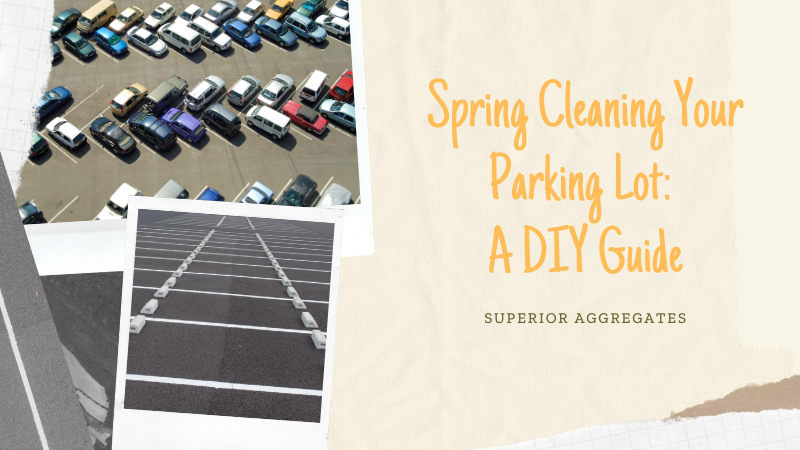
How to Sealcoat Edges
No matter why or where you are building a parking lot or sidewalk, sealcoating the edges is important for various reasons. By simply adding a thin liquid layer over the paved surfaces, sealcoating can help you maintain your parking lot or sidewalk for many years to come. That said, the following is an overview of the benefits of sealcoating as well as the steps you need to take to properly sealcoat your sidewalks and parking lots.
Benefits of Sealcoating
If you are wondering why you should sealcoat your sidewalks and parking lots, the most common benefits are as follows:
- Prolongs Life Expectancy: One of the top benefits of sealcoating is that it helps to prolong the life expectancy of the asphalt pavement by providing a protective layer that helps to safeguard it against water, vehicle fluids, UV rays, and more. It also helps to fill in surface damage.
- Saves Money: Given that sealcoating is a low-cost method, this helps you to save money over time on maintenance and other repairs.
- Enhances Appearance: No matter if the asphalt is new or old, a fresh sealcoat will make your sidewalk or pavement look shiny and new.
- Ice and Snow Protection: One special benefit of sealcoating is that it helps to accelerate the melting of ice and snow. Moreover, it also helps to protect the pavement from related issues such as water penetration, frost and/or snow damage.
- Repair Minor Cracks and Other Wear and Tear: The process also allows you to repair minor cracks and other issues caused by everyday wear and tear.
How to Sealcoat
Now that we’ve gone over the benefits of sealcoating, let’s take a look at the steps you need to take to sealcoat your asphalt:
- Preparation: Before you can begin installing your sealcoat, you must prepare the area you are sealing. This means you will take the type to assess the condition of the area, clean the area with tools such as rotary brooms, commercial sweepers, and hand steel brooms. From there, you need to shut off nearby sources of water runoff, such as sprinkler systems.
- Repair: Once you have prepared the area, you must take the time to repair it. This involves filling cracks, repairing areas that have been seriously damaged, and repair things such as potholes.
- Application: After that, you will need to prepare the mixture to be applied to the asphalt. For longer-lasting results, apply two coats.
- Re-Striping: From there, you will need to re-stripe the pavement and/or apply any necessary markings that were covered during the process.
- Clean-Up: Lastly, you need to take the time to clean up and discard or store any trash and materials that are leftover.
Overall, if you are considering applying a sidewalk or parking lot sealcoat, you certainly should. Not only can it help to protect the pavement against ice and snow, extend the life of the pavement, help you save money on potentially costly repairs, and much more. While the process of applying a sealcoat is relatively easy, you should be sure that you have enough experience, knowledge, and stamina to complete such a job if you wish to do it yourself. Other than that, be sure to hire a qualified construction company you can trust.
No matter why or where you are building a parking lot or sidewalk, sealcoating the edges is important for various reasons. By simply adding a thin liquid layer over the paved surfaces, sealcoating can help you maintain your parking lot or sidewalk for many years to come. That said, the following is an overview of the benefits of sealcoating as well as the steps you need to take to properly sealcoat your sidewalks and parking lots.
Benefits of Sealcoating
If you are wondering why you should sealcoat your sidewalks and parking lots, the most common benefits are as follows:
- Prolongs Life Expectancy: One of the top benefits of sealcoating is that it helps to prolong the life expectancy of the asphalt pavement by providing a protective layer that helps to safeguard it against water, vehicle fluids, UV rays, and more. It also helps to fill in surface damage.
- Saves Money: Given that sealcoating is a low-cost method, this helps you to save money over time on maintenance and other repairs.
- Enhances Appearance: No matter if the asphalt is new or old, a fresh sealcoat will make your sidewalk or pavement look shiny and new.
- Ice and Snow Protection: One special benefit of sealcoating is that it helps to accelerate the melting of ice and snow. Moreover, it also helps to protect the pavement from related issues such as water penetration, frost and/or snow damage.
- Repair Minor Cracks and Other Wear and Tear: The process also allows you to repair minor cracks and other issues caused by everyday wear and tear.
How to Sealcoat
Now that we’ve gone over the benefits of sealcoating, let’s take a look at the steps you need to take to sealcoat your asphalt:
- Preparation: Before you can begin installing your sealcoat, you must prepare the area you are sealing. This means you will take the type to assess the condition of the area, clean the area with tools such as rotary brooms, commercial sweepers, and hand steel brooms. From there, you need to shut off nearby sources of water runoff, such as sprinkler systems.
- Repair: Once you have prepared the area, you must take the time to repair it. This involves filling cracks, repairing areas that have been seriously damaged, and repair things such as potholes.
- Application: After that, you will need to prepare the mixture to be applied to the asphalt. For longer-lasting results, apply two coats.
- Re-Striping: From there, you will need to re-stripe the pavement and/or apply any necessary markings that were covered during the process.
- Clean-Up: Lastly, you need to take the time to clean up and discard or store any trash and materials that are leftover.
Overall, if you are considering applying a sidewalk or parking lot sealcoat, you certainly should. Not only can it help to protect the pavement against ice and snow, extend the life of the pavement, help you save money on potentially costly repairs, and much more. While the process of applying a sealcoat is relatively easy, you should be sure that you have enough experience, knowledge, and stamina to complete such a job if you wish to do it yourself. Other than that, be sure to hire a qualified construction company you can trust.

